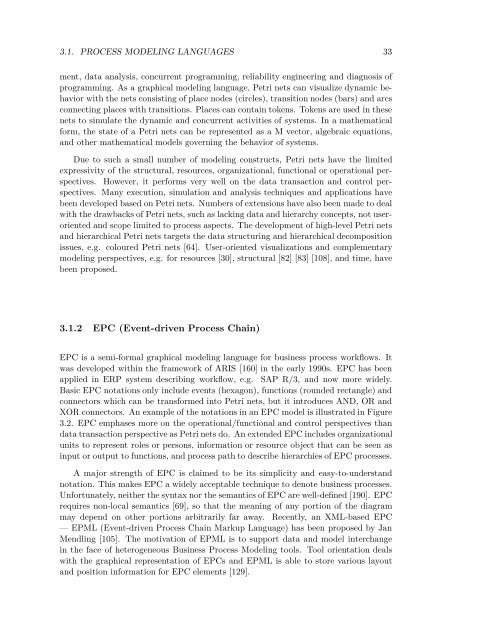Semantic Annotation for Process Models: - Department of Computer ...
Semantic Annotation for Process Models: - Department of Computer ...
Semantic Annotation for Process Models: - Department of Computer ...
You also want an ePaper? Increase the reach of your titles
YUMPU automatically turns print PDFs into web optimized ePapers that Google loves.
3.1. PROCESS MODELING LANGUAGES 33<br />
ment, data analysis, concurrent programming, reliability engineering and diagnosis <strong>of</strong><br />
programming. As a graphical modeling language, Petri nets can visualize dynamic behavior<br />
with the nets consisting <strong>of</strong> place nodes (circles), transition nodes (bars) and arcs<br />
connecting places with transitions. Places can contain tokens. Tokens are used in these<br />
nets to simulate the dynamic and concurrent activities <strong>of</strong> systems. In a mathematical<br />
<strong>for</strong>m, the state <strong>of</strong> a Petri nets can be represented as a M vector, algebraic equations,<br />
and other mathematical models governing the behavior <strong>of</strong> systems.<br />
Due to such a small number <strong>of</strong> modeling constructs, Petri nets have the limited<br />
expressivity <strong>of</strong> the structural, resources, organizational, functional or operational perspectives.<br />
However, it per<strong>for</strong>ms very well on the data transaction and control perspectives.<br />
Many execution, simulation and analysis techniques and applications have<br />
been developed based on Petri nets. Numbers <strong>of</strong> extensions have also been made to deal<br />
with the drawbacks <strong>of</strong> Petri nets, such as lacking data and hierarchy concepts, not useroriented<br />
and scope limited to process aspects. The development <strong>of</strong> high-level Petri nets<br />
and hierarchical Petri nets targets the data structuring and hierarchical decomposition<br />
issues, e.g. coloured Petri nets [64]. User-oriented visualizations and complementary<br />
modeling perspectives, e.g. <strong>for</strong> resources [30], structural [82] [83] [108], and time, have<br />
been proposed.<br />
3.1.2 EPC (Event-driven <strong>Process</strong> Chain)<br />
EPC is a semi-<strong>for</strong>mal graphical modeling language <strong>for</strong> business process workflows. It<br />
was developed within the framework <strong>of</strong> ARIS [160] in the early 1990s. EPC has been<br />
applied in ERP system describing workflow, e.g. SAP R/3, and now more widely.<br />
Basic EPC notations only include events (hexagon), functions (rounded rectangle) and<br />
connectors which can be trans<strong>for</strong>med into Petri nets, but it introduces AND, OR and<br />
XOR connectors. An example <strong>of</strong> the notations in an EPC model is illustrated in Figure<br />
3.2. EPC emphases more on the operational/functional and control perspectives than<br />
data transaction perspective as Petri nets do. An extended EPC includes organizational<br />
units to represent roles or persons, in<strong>for</strong>mation or resource object that can be seen as<br />
input or output to functions, and process path to describe hierarchies <strong>of</strong> EPC processes.<br />
A major strength <strong>of</strong> EPC is claimed to be its simplicity and easy-to-understand<br />
notation. This makes EPC a widely acceptable technique to denote business processes.<br />
Un<strong>for</strong>tunately, neither the syntax nor the semantics <strong>of</strong> EPC are well-defined [190]. EPC<br />
requires non-local semantics [69], so that the meaning <strong>of</strong> any portion <strong>of</strong> the diagram<br />
may depend on other portions arbitrarily far away. Recently, an XML-based EPC<br />
— EPML (Event-driven <strong>Process</strong> Chain Markup Language) has been proposed by Jan<br />
Mendling [105]. The motivation <strong>of</strong> EPML is to support data and model interchange<br />
in the face <strong>of</strong> heterogeneous Business <strong>Process</strong> Modeling tools. Tool orientation deals<br />
with the graphical representation <strong>of</strong> EPCs and EPML is able to store various layout<br />
and position in<strong>for</strong>mation <strong>for</strong> EPC elements [129].
















